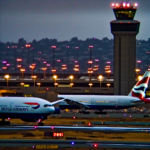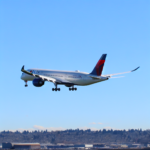SEATTLE- A Delta Air Lines (DL) flight, designated DL170, was traveling from Seoul Incheon Airport (ICN) to Minneapolis–Saint Paul International Airport (MSP) when it was compelled to make an emergency landing at Seattle–Tacoma International Airport (SEA) on July 6, 2025.
The flight was diverted mid-journey due to a critical medical situation involving an elderly passenger. Fortunately, the aircraft landed safely at SEA, where medical personnel were immediately on hand to assist the passenger upon arrival.
The emergency unfolded over the Pacific Ocean, situated between Alaska and Washington, approximately three hours away from Seattle.
According to eyewitness accounts from passengers, the elderly individual, believed to be in his 70s, became unresponsive and exhibited signs of low oxygen saturation (hypoxia). As a precaution, flight attendants called for any medical professionals on board. A doctor and nurse quickly stepped forward to help.
The passenger was found slouched in his seat and responded minimally to inquiries. Earlier in the day, he had reported experiencing chest pain. Onboard responders provided oxygen while coordinating assistance with Delta’s ground medical team.
Despite some signs of slight improvement, it was determined that a diversion to Seattle would ensure the individual received timely medical attention.
Upon arriving at Seattle–Tacoma International Airport, emergency medical technicians (EMTs) were prepared at the gate to facilitate a quick transfer of the passenger for further treatment. Delta’s swift response and efficient coordination with ground services ensured that the passenger received critical care with little delay.
The aircraft was kept grounded for an additional two hours because of regulations surrounding the flight crew’s duty limits. Eventually, passengers were allowed to disembark as alternative arrangements were being organized.
Passenger Rebooking Challenges After Diversion
<pmany passengers,="" including="" those="" with="" layovers="" at="" msp,="" encountered="" unexpected="" delays="" and="" logistical="" headaches.="" the="" rebooking="" procedures="" sea="" faced="" challenges="" due="" to="" system="" limitations,="" as="" delta’s="" app="" did="" not="" acknowledge="" seattle="" new="" destination="" for="" several="" hours.
Numerous travelers relied on the assistance of in-terminal agents, who grappled with manual rebooking processes that included lengthy phone verification.
While some were able to secure seats on later direct flights to their intended destinations, others had no choice but to wait until the aircraft was prepared to continue its journey with a fresh flight crew. Many expressed frustration over the cumbersome workflows related to rebookings following the diversion.
Although the emergency landing highlighted effective collaboration among in-flight personnel, medical experts, and airport responders, the challenges faced after the diversion revealed significant areas for operational enhancement.
Issues such as inconsistent app updates, intricate rebooking methods, and a heavy reliance on manual interventions underscored the need for improved contingency planning in these situations.
Despite the disruptions, passengers recognized and appreciated the professionalism exhibited by the Delta Air Lines crew and the medical responders who acted rapidly to handle the health emergency midair.
Technical ACARS Message
Examining the details from the ACARS message:
Message Header:
- Aircraft: A359 (Airbus A350-900)
- Registration: N508DN (Delta Air Lines)
- Flight: DL170
- ICAO Code: A65800
- Source: L-98W (likely a ground station)
- Time: 2025-07-06 18:16:01 UTC
Message Content: This appears to be a diversion message which includes two key components:
Part 1 – Initial Diversion Notice:
- AES (Aircraft Earth Station) message indicating a diversion alert
- Government rules applicable to all diversions
- Timing details of the flight (from takeoff to landing)
- Captain’s instructions regarding passenger management during the diversion
Part 2 – Amended Flight Plan:
- Medical emergency necessitating a diversion to KSEA (Seattle-Tacoma International Airport)
- The original destination was likely an international airport
- Aircraft received direct routing to accommodate the emergency
- Weight considerations: approximately 3000 lbs above the maximum structural landing weight
- Fuel dumping and inspection were required upon landing
- Replan from 5000N13959 (possibly a waypoint over the Pacific)
Flight Details:
- Altitude: Not specified, clearance index 12
- Data on fuel, time, and burn provided
- 10% fuel reserves maintained
- RVSM (Reduced Vertical Separation Minimum) clearance at FL330/6553
Stay updated with us and follow us on social media for the latest aviation insights.
Join us on Telegram Group for the latest aviation updates and follow us on Google News.

Based on an article from aviationa2z.com: https://aviationa2z.com/index.php/2025/07/09/delta-seoul-minneapolis-flight-emergency-landing-at-seattle/?utm_source=rss&utm_medium=rss&utm_campaign=delta-seoul-minneapolis-flight-emergency-landing-at-seattle



